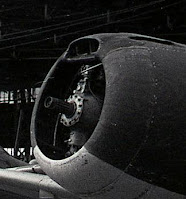In the previous post, George Bryant noticed that possibly one more "Hayate" did not have anti-glare panels. D. Chouinard asked: "Did they ever stop painting the anti glare panel at the factory to save time during the finishing process?"
Below is a set of most interesting photos of "Hayate" and Nakajima Ki-115 "Tsurugi" I recently discovered HERE. Lovely "Tsurugi" cockpit photo, right?
Indeed it seems that all the "Hayate" are without anti-glare panels but why are the "Tsurugi" (a suicide a/c) with one? Note that in the bottom photo, the "Tsurugi" in the foreground are painted in "green" camo WITH anti-glare, the "Hayate" without. What's the logic behind that?
Michael Thurow offered some thoughts:
My suggestion: The anti-glare panel was intended to protect pilot's view from reflecting natural metal surfaces. Until the introduction of brown-olive camouflage at factory level at the end of 1944 Army planes had either a silver or grey-green factory finish. All dark green paint (solid or in blotches) was depot-applied. The new matte brown colour eliminated the need for additional anti-glare protection.
A similar transition can be observed for IJN aircraft (and in reversed order for USAAF planes).
An afterthought on the camouflaged Tsurugi WITH anti-glare in the last picture. It looks like they were initially intended without camouflage and consequently received an anti-glare area while the Hayate are already built to the latest colour spec. I wouldn't be surprised if the Tsurugi remained silver on the undersides.
Michael Thurow offered some thoughts:
My suggestion: The anti-glare panel was intended to protect pilot's view from reflecting natural metal surfaces. Until the introduction of brown-olive camouflage at factory level at the end of 1944 Army planes had either a silver or grey-green factory finish. All dark green paint (solid or in blotches) was depot-applied. The new matte brown colour eliminated the need for additional anti-glare protection.
A similar transition can be observed for IJN aircraft (and in reversed order for USAAF planes).
An afterthought on the camouflaged Tsurugi WITH anti-glare in the last picture. It looks like they were initially intended without camouflage and consequently received an anti-glare area while the Hayate are already built to the latest colour spec. I wouldn't be surprised if the Tsurugi remained silver on the undersides.
Correct Michael but the official instructions called for the brown-olive finished aircraft to have anti-glare. That's why we have the "Hayate" of the 102 Sentai and other units covered before.
I just checked Gakken #46, p.44-45 and the caption says that although not immediately visible the anti-glare is there and was applied to factory a/c until the end of the war. The photo on the lower of p.45 shows anti-glare and if you look very closely at some of the aircraft in the above photos you can barely see the anti-glare on some of them at the very edge of the nose. Curious that it is not that visible.









My suggestion: The anti-glare panel was intended to protect pilot's view from reflecting natural metal surfaces. Until introduction of brown-olive camouflage at factory level at the end of 1944 Army planes had either a silver or grey-green factory finish. All dark green paint (solid or in blotches) was depot-applied. The new matte brown colour eliminated the need for additional anti-glare protection.
ReplyDeleteA similar transition can be observed for IJN aircraft (and in reversed order for USAAF planes).
An afterthought on the camouflaged Tsurugi WITH anti-glare on the last picture. It looks like they were initially intended without camouflage and consequently received an anti-glare area while the Hayate are already built to the latest colour spec. I wouldn't be surprised if the Tsurugi remained silver on the undersides.
ReplyDeleteInteresting. I hope you don't mind if I come back on this once more. An anti-glare line is possibly visible right in front of the windscreen (not on the nose - that's a panel line).
ReplyDeleteThere are quite a number of pictures of Ki-84 and Ki-43-III that make it very hard to believe there are anti-glare areas (while others clearly show them), and of Ki-100 which are definitely missing them.
Whatever the official directive, ease of manufacturing towards war end may have dictated a less stringent approach.
Not a problem Michael, always happy of conversations. Check the close-up I just posted.
ReplyDeleteSure, I agree with you on the less strigent approach.
After viewing these photos, I realized that they look a bit familiar. FAOW #3 1985, pg. 22-23 has a set of photos of possibly the same factory. The big difference is that in FAOW #3 all of the aircraft are still on their landing gear. The line up of aircraft is almost identical and the close up shots of the Ki-84 reveals the black anti-glare panel barely visible as in the last photo above.
ReplyDeleteThe Ki-115 photos provide some great inspiration to model an abandoned aircraft.